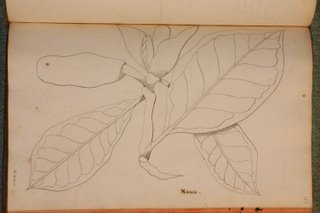josef george kamel, s.j. drawing of nangka or jackfruit

Nangka [Artocarpus heterophyllus Lamk. Syn: A. integra (Thunb.) Merr.] Syn: Nanca, langka belongs to the breadfruit genus of the Moraceæ family. Its close relations are camansi (A. altilis (Parkins) Fosb), antipolo or tipolo (A. blancoi (Elm.) Merr.), kubi (A. nitidus) and marang (A. odoratissimus). It is known in English as jackfruit.
Nangka grows to 15 m, has a milky sap and produces female and male heads. Fruits generally develop in new growth around the trunk as the fully mature fruit can be as large as 60 cm. The composite fruit matures from green turning yellow when ripe. Inside the ripe nangka, pockets of golden yellow flesh surround numerous seeds. This is eaten as is, after removing the seed. The golden flesh is used for dessert, for which it can be preserved by boiling in syrup. This sweetened nangka is an ingredient in halo-halo. Nangka is also cooked with saba or frying banana when making turon. Nangka ice cream is a unique product of the Philippines.
Green nangka is treated as a vegetable and cooked with coconut milk flavored with a bit of meat or shrimp. The seeds can be boiled or roasted and eaten like a nut.
Nangka wood, when dried and properly treated is used for manufacturing guitars in Cebu. Elsewhere in Asia, the wood is used for stringed and percussion instruments.

0 Comments:
Post a Comment
<< Home